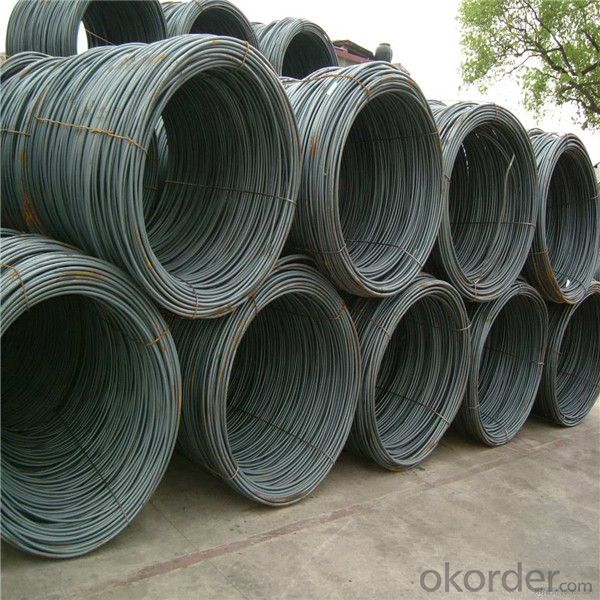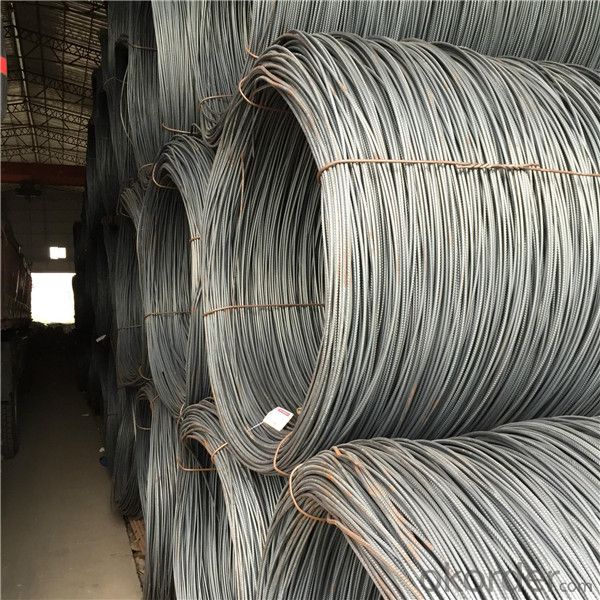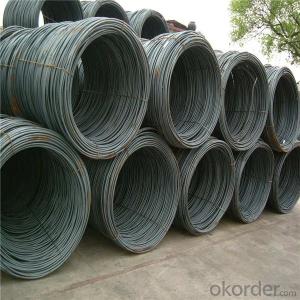Steel Wire Rod SAE1008 in different diameter
- Loading Port:
- Shanghai
- Payment Terms:
- TT OR LC
- Min Order Qty:
- 50 m.t.
- Supply Capability:
- 15621 m.t./month
OKorder Service Pledge
OKorder Financial Service
You Might Also Like
Item specifice
Produced from billets at the rolling mill, wire rod is the basis of all steel wire, rope and fencing products.
The most important characteristic in determining wire rod’s end use is its drawability. Common low carbon
wire rod is used for nails, small shaped products, barbed wires, various wire nettings, steel chains, and
other applications. High Carbon wire rod uses include steel tire cords for automobiles, conveyor belts, and
pressure hoses. Other applications include bolts, nuts, and machine parts, as well as compression, tension
and torsion springs
Mainly used in building and construction as binding wire, tie wire and baling wire; also can be make for wire mesh.
Our Advantage: High quality steel products from 1 class mills in
Reasonable price
Professionalism of the products
On-time delivery
Complete documents and certificates
Sincere service to meet our clients' requirements
Product Description :
Standard | AISI, ASTM, BS, DIN, GB, JIS |
Material/steel grade | Q195-Q235,SAE1006B,SAE1006CR, SAE1008B, SAE1008CR, SAE1010B, SAE1018B, or according to customers requirements |
Wire Gauge | 5.5-12mm |
Coil weight | 1.8-2.1mts |
MOQ | 25MT |
Delivery Time | 15-30 days after receipt of L/C or deposit by T/T |
Packing | In coil and load in container, if large quantity, by bulk vessel; Can be packed as customers' special requirements |
Payment terms | 1).100% irrevocable L/C at sight. 2).30% T/T prepaid and the balance against the copy of B/L. 3).30% T/T prepaid and the balance against L/C |
Application | widely used in machinery parts, manufacturing industry, electronics industry, metal tools and others |



Application :
It generally used in braiding the hose for bathing product and machinery. With it
good flexibility, resistant to high temperature and resistant to corrosion, it
used widely in many industries.
Packing :
Hot-rolled wire rod is held in a unit with at least four steel straps in the
transverse direction and transported and stored without further packaging.
Before
the steel strapping is applied, the wire rod must be sufficiently compressed.
The strapping is fixed in the transverse direction with a single circumferential
strap so that the strapping does not slip and cause the coil to come apart.


Our service:
(1) We cooperate with famous factories with advanced equipment and well trained workers.
(2) We can provide factory price with trading company service.
(3) We continuously work on the improvement of our processes, guaranteeing
consistently high standards of quality to keep none compensation.
(4) We guarantee 24 hours response and 48 hours solution providing service.
(5) We accept small order quantity before formal cooperation.
(6) We deliver the agreed quality at the agreed time, reacting to changes in
customer wishes in a flexible way.
(7) Due to our volume and selling power, we have excellent freight rates with
shipping lines.
(8) We strive to always be fair and honest in our dealings with customers.
(9) We strive to work together with customers to achieve much more than we can
achieve alone.
(10) Through our passion and commitment we aim to be a market leader in all our
key markets. To maintain our position as market leader we must continue to add
value in all that we do.
FAQ:
1.Q: What's your MOQ(minimum order quantity)?
A: One full container, mixed acceptable .
2. Q: What's your packing methods?
A: Packed in bundle or bulk ..
3. Q: How can I buy CNBM products in my country?
A:Please send us an inquiry or email ,we will reply to you if there is distributor in your country
4. Q: Can we visit your factory?
A: Warmly welcome. Once we have your schedule, we will arrange the
professional sales team to follow up your case.
5. Q: How long does it take to get the product if i place an order?
A:With the process of your requirements,we will pack and deliver in 3
-7 days. If it is by sea shipment,it will take 15-45 days depending on different locations
- Q:What are the main factors influencing the choice of steel wire rod production process?
- The choice of steel wire rod production process is influenced by several key factors. Firstly, the quality requirements of the final product play a crucial role. Different production processes have varying capabilities to produce steel wire rods with specific properties such as strength, ductility, and surface finish. The desired characteristics of the wire rod will dictate the choice of production process. Secondly, the cost-effectiveness of the production process is an important consideration. Factors such as energy consumption, raw material utilization, and labor requirements can significantly impact the overall cost of production. Different processes may have varying efficiencies and costs, and these factors need to be evaluated to ensure the most economical choice. Furthermore, the availability and cost of raw materials also influence the selection of the production process. Steel wire rod can be produced from different types of steel, such as carbon steel, alloy steel, or stainless steel. The choice of raw material depends on factors such as required mechanical properties, availability, and cost. The production process must be compatible with the selected raw material. Another factor influencing the choice is the production capacity and scalability of the process. Some processes may be more suitable for small-scale production, while others are better suited for large-scale manufacturing. The desired production volume and scalability requirements need to be considered to ensure the chosen process can meet the production demands. Additionally, environmental considerations can also impact the choice of production process. Some processes may generate more waste or emit higher levels of pollutants compared to others. Companies may prioritize sustainable and environmentally friendly production methods, leading them to select a process that minimizes environmental impact. Overall, the main factors influencing the choice of steel wire rod production process are the desired product quality, cost-effectiveness, availability and cost of raw materials, production capacity and scalability, and environmental considerations. A careful evaluation of these factors is necessary to select the most suitable production process for a specific application.
- Q:How does the thermal conductivity of steel wire rod vary with different grades?
- The thermal conductivity of steel wire rod typically varies with different grades. Higher-grade steel wire rod tends to have a higher thermal conductivity compared to lower-grade steel wire rod. This is because higher-grade steel wire rod is usually made with superior quality materials and has a more refined structure, allowing for better heat transfer. However, it is important to note that the exact variation in thermal conductivity can depend on various factors such as alloy composition, heat treatment, and processing techniques used during the manufacturing process.
- Q:Can steel wire rod be used for reinforcement purposes?
- Yes, steel wire rod can be used for reinforcement purposes. Steel wire rod is often used to reinforce concrete structures such as buildings, bridges, and highways. This is because steel has high tensile strength and can withstand heavy loads and stresses. When embedded in concrete, the steel wire rod helps to increase the overall strength and durability of the structure. It also helps to prevent cracking and improve the structural integrity. Steel wire rod is commonly used in the construction industry for reinforcement purposes due to its excellent mechanical properties and ability to enhance the performance of concrete structures.
- Q:How is steel wire rod used in the manufacturing of wire for power transmission lines?
- The manufacturing process for wire used in power transmission lines relies heavily on steel wire rod. This essential component serves as the raw material for creating high-strength conductors that carry electrical energy across vast distances. To begin the manufacturing process, high-quality steel wire rods are carefully selected. These rods are typically made from either carbon steel or alloy steel. They then undergo a series of processes, including heating, rolling, and drawing, to transform them into wires with specific diameters and strengths. The primary role of the steel wire rod is to provide the necessary mechanical strength and conductivity required for power transmission lines. Steel is known for its exceptional tensile strength, which enables the wire to withstand the immense tension and stress experienced during installation and operation of transmission lines. Moreover, steel wire rod offers excellent electrical conductivity. This means that it allows electricity to flow efficiently through the wire, minimizing power loss and ensuring optimal transmission efficiency over long distances. The manufactured wire, which is made from steel wire rod, is typically stranded together to create a conductor. Multiple layers of these steel wire strands are then wound around a central core to form a composite conductor. This design enhances the wire's strength and flexibility, making it suitable for enduring extreme weather conditions, wind, and ice loads. Furthermore, steel wire rod plays a critical role in ensuring the durability and reliability of power transmission lines. Its corrosion resistance properties protect the wire from environmental factors such as moisture and chemical exposure, which could otherwise compromise the integrity of the line. To summarize, steel wire rod is essential in the manufacturing of wire for power transmission lines due to its exceptional tensile strength, electrical conductivity, and corrosion resistance properties. It enables the production of high-quality conductors that can efficiently transmit electrical energy over long distances while enduring various environmental challenges and ensuring uninterrupted power supply.
- Q:What are the different coating options available for steel wire rod?
- Steel wire rod has a variety of coating options available, each with its own unique benefits and characteristics. Some commonly used coatings include: 1. Galvanized Coating: A widely favored option, galvanized coating involves applying a layer of zinc to the wire rod's surface. This provides exceptional corrosion resistance and enhances durability and lifespan. 2. Epoxy Coating: Applied to protect against corrosion and abrasion, epoxy coating creates a smooth and durable surface that prevents moisture and corrosive elements from reaching the wire rod. 3. Polymer Coating: Ideal for wire rod exposed to harsh environments, polymer coatings offer excellent resistance to corrosion, chemicals, and UV radiation. They also enhance the wire rod's aesthetic appearance. 4. Phosphating Coating: By chemically treating the wire rod, phosphating coating enhances corrosion resistance. It converts the surface into a layer of phosphate crystals, creating a protective barrier against rust and other forms of corrosion. 5. Powder Coating: Suitable for wire rod requiring a decorative finish, powder coating involves applying a dry powder to the wire rod and baking it to create a hard and durable coating. It provides excellent resistance to corrosion, chemicals, and scratches. 6. Ceramic Coating: Used for wire rod in extreme temperatures or abrasive environments, ceramic coatings offer excellent resistance to heat, wear, and corrosion. They also enhance the wire rod's strength and durability. Choosing the appropriate coating option is crucial and should be based on specific requirements and the intended application of the wire rod. Consulting with a coating specialist or manufacturer can help determine the most suitable coating option for the desired purpose.
- Q:How is steel wire rod used in the manufacturing of wire for suspension cables?
- Steel wire rod is a crucial component in the manufacturing of wire for suspension cables as it serves as the primary raw material. The steel wire rod is first drawn through a series of dies to reduce its diameter and increase its strength. This process, known as wire drawing, helps create the desired thickness and tensile strength required for suspension cables. The drawn wire is then further processed, usually through stranding or twisting, to form multiple strands, which are then combined to create the final suspension cable. The high strength and durability of steel wire rod make it an ideal material for suspension cables, ensuring the cables can safely support heavy loads and withstand the environmental stresses they will encounter.
- Q:What are the different types of steel wire rod surface treatments after wire drawing?
- There are several types of steel wire rod surface treatments after wire drawing, including galvanizing, zinc coating, phosphating, and powder coating. These treatments are applied to enhance the wire's corrosion resistance, increase durability, and improve its appearance.
- Q:What are the main factors influencing the choice of steel wire rod surface finish?
- When determining the appropriate surface finish for a steel wire rod, several factors come into play, each playing a significant role. The intended use of the wire rod is one of the main factors to consider. Different surface finishes offer varying levels of corrosion resistance, lubricity, and adhesion properties. These properties are crucial in determining whether the wire rod is suitable for a specific application. For instance, in a corrosive environment, a surface finish that provides enhanced resistance to rust and oxidation may be necessary. The desired aesthetic appearance is another factor that influences the choice of surface finish. Industries like automotive or consumer goods may have specific requirements for the visual appeal of the wire rod. In such cases, finishes that offer a smooth, polished, or decorative appearance may be preferred. The mechanical properties required for the wire rod's application also play a role in determining the surface finish. Some finishes, such as bright or polished surfaces, can improve the wire rod's yield strength, ductility, and fatigue resistance. These properties are vital in applications involving high-stress conditions or requiring flexibility and durability. Cost considerations are also important when selecting the surface finish. Some finishes require additional processing steps, like pickling, coating, or electroplating, which can increase the overall cost of the wire rod. Therefore, it is essential to balance the desired surface finish with the cost-effectiveness of the manufacturing process. Lastly, environmental and regulatory factors can influence the choice of surface finish. Certain finishes may contain hazardous substances or require specific disposal methods, impacting the environmental footprint of wire rod production. Compliance with industry standards and regulations is crucial to ensure the safety and sustainability of the finished product. In conclusion, the choice of steel wire rod surface finish is influenced by factors such as intended use, aesthetic requirements, mechanical properties, cost considerations, and environmental considerations. By carefully considering these factors, manufacturers can select the most appropriate surface finish that aligns with the specific requirements of the application and ensures optimal performance and quality of the wire rod.
- Q:What are the common raw materials used in steel wire rod production?
- The common raw materials used in steel wire rod production are iron ore, coal, limestone, and scrap metal.
- Q:How is the demand for steel wire rod influenced by global economic trends?
- The demand for steel wire rod is significantly influenced by global economic trends. As steel wire rod is a critical raw material used in various industries such as automotive, construction, and manufacturing, any changes in the global economic landscape can have a direct impact on its demand. During periods of economic growth and industrial expansion, the demand for steel wire rod tends to increase. This is because increased construction activities, infrastructure development, and manufacturing output require large quantities of steel wire rod for applications such as reinforcement in concrete, electrical wiring, and fasteners. Conversely, during economic downturns or recessions, the demand for steel wire rod tends to decline. Reduced construction projects, lower consumer spending, and decreased manufacturing activities result in a decreased need for steel wire rod. Industries that heavily rely on steel wire rod, such as automotive and construction, often experience a decline in demand during such periods. Global economic trends also play a crucial role in determining the prices of steel wire rod. Fluctuations in currency exchange rates, trade policies, and supply and demand dynamics can impact the cost of raw materials, transportation, and production, which in turn affects the price of steel wire rod. For instance, increased trade tensions between countries can lead to tariffs or trade restrictions, affecting the availability and cost of steel wire rod in global markets. Additionally, global economic trends can influence the geographical distribution of steel wire rod production and consumption. As countries experience shifts in economic growth, emerging markets may witness a surge in demand for steel wire rod due to their expanding infrastructure and construction activities. This can lead to a redistribution of production facilities and investments in these regions to cater to the growing demand. Overall, the demand for steel wire rod is strongly influenced by global economic trends. Understanding these trends and their impact on industries that rely on steel wire rod is crucial for stakeholders in the steel industry to effectively manage their production, pricing, and market strategies.
1. Manufacturer Overview |
|
|---|---|
| Location | |
| Year Established | |
| Annual Output Value | |
| Main Markets | |
| Company Certifications | |
2. Manufacturer Certificates |
|
|---|---|
| a) Certification Name | |
| Range | |
| Reference | |
| Validity Period | |
3. Manufacturer Capability |
|
|---|---|
| a)Trade Capacity | |
| Nearest Port | |
| Export Percentage | |
| No.of Employees in Trade Department | |
| Language Spoken: | |
| b)Factory Information | |
| Factory Size: | |
| No. of Production Lines | |
| Contract Manufacturing | |
| Product Price Range | |
Send your message to us
Steel Wire Rod SAE1008 in different diameter
- Loading Port:
- Shanghai
- Payment Terms:
- TT OR LC
- Min Order Qty:
- 50 m.t.
- Supply Capability:
- 15621 m.t./month
OKorder Service Pledge
OKorder Financial Service
Similar products
New products
Hot products
Related keywords



























